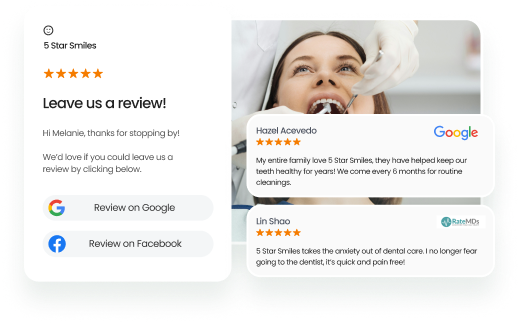How do you know if you have transitioned from building a brand to becoming a household name? You measure the “Share of Voice” your brand has across marketing channels. This metric lets you understand how much your community speaks of your business vs. your competitors.
Becoming the go-to recommendation in your community is the ultimate goal, no matter how many locations you have. But doing that is almost impossible without understanding the current market visibility, comparing it with competitors, and analyzing it.
“Share of Voice” may seem abstract, but it can be a critical tool to set your enterprise for success, especially when scaling new office/store locations. This blog is your complete guide to understanding the definition of Share of Voice and how to make the most of it across ads, search, social media, and reputation sites.
We also have a very engaging share of voice calculator for you to try out – click here to jump right to it.
Table of contents
- What is Share of Voice (SOV)?
- Importance of Share of Voice for multi-location businesses
- Share of Voice (SOV) vs. Share of Market (SOM)
- How do you calculate Share of Voice?
- Share of voice calculator tool
- SOV calculation mistakes to avoid
- How to measure Share of Voice across channels
- Share of voice tools
- Pitfalls of relying on SOV exclusively
- Share of Voice analysis: Best practices for success
- Share of Voice – A good starting point
- FAQs on share of voice
- Supercharge your Share of Voice with Birdeye’s GenAI tools
What is Share of Voice (SOV)?
Share of Voice or Share of visibility is a critical marketing metric for businesses to measure their presence across essential channels such as organic search, SEO, social media, listing sites, media, and more.
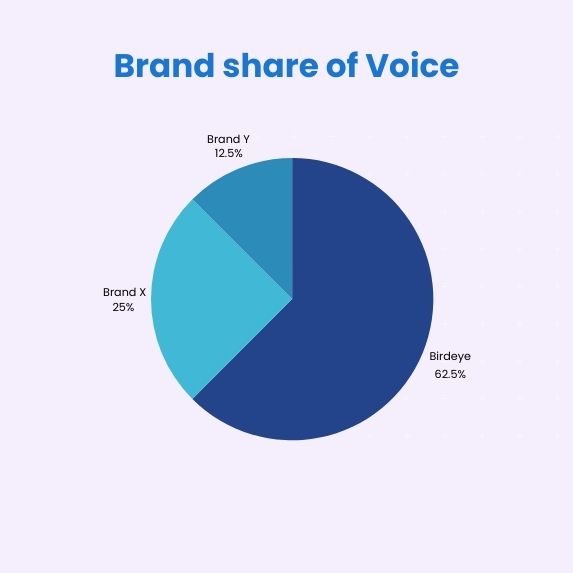
Brand Share of Voice = Digital share of voice + Offline Share of Voice
Share of Voice can help businesses overtake their competitors and identify channels where investments are necessary to boost the existing presence.
However, it is essential to note that measuring Share of Voice across paid advertising channels, search, and social media platforms only tells you how much your brand is spoken of, without conveying anything about the sentiment behind the conversations.
While measuring brand Share of Voice can be a good place to start, it can only show half the picture without analyzing review sentiment, survey responses, and social media mentions/reputation.
What is a good share of voice percentage?
There is no absolute number that businesses must aim to hit when it comes to digital share of voice. However, having a larger presence than your competitors on target channels is important as it signifies your target audience is actively engaged with your brand.
So, any number bigger than any individual or total of all competitor presence is good news.
Now that we have a good hold on the Share of Voice definition, let us move on to understanding its importance and applications for growing businesses across multiple marketing channels.
Importance of Share of Voice for multi-location businesses
Measuring presence across multiple channels can be challenging, but comes with a horde of benefits that businesses can’t afford to miss out on. Measuring share of voice metrics ensures that you can:
- Understand your target audience across locations
- Analyze marketing campaign success against local and global competitors
- Manage brand growth across locations
Let us dive into these benefits in detail.
Understand the target audience across locations
Multi-location brands face distinct audience behaviors in different regions. Share of Voice analysis helps you understand consumer interests across locations, identify where your brand resonates, and where market research can help more.
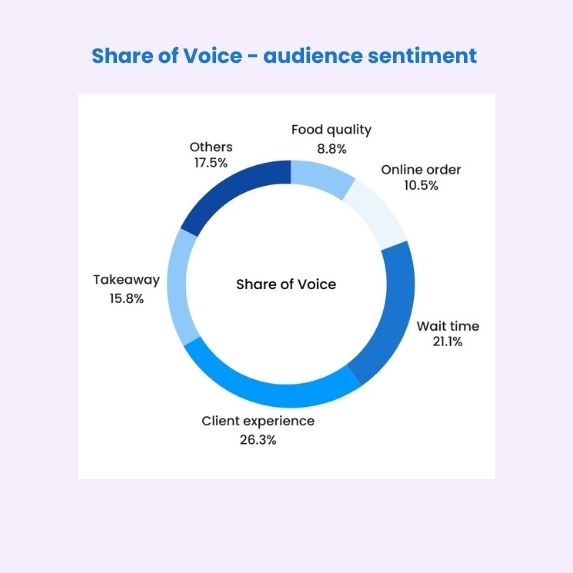
You can also identify location-specific marketing channels to engage your audience better.
Analyze marketing campaign success against local and global competitors
Most brands run brand awareness-based campaigns across various marketing channels. Attributing leads to these campaigns is always tricky, and most marketers struggle to quantify the ROI for such marketing strategies. However, measuring Share of Voice on those specific channels can tell you:
- The current presence or visibility of your brand after the campaign
- The increase in your visibility before and after the campaign in comparison to a competitor
Knowing these metrics allows businesses to intelligently invest across channels so that campaigns reap the growth results they require.
Manage brand growth across locations
Monitoring and actively managing brand growth can be complicated, especially for multi-location businesses. While measuring revenue, walk-ins, or customer growth can help a lot, SOV insights can also come in handy.
For example, if a particular location is struggling but can’t find a singular reason, analyzing SOV across channels can tell you if brand awareness is the issue. You can turn the growth graph around by giving the location a push on visibility.
Share of Voice (SOV) vs. Share of Market (SOM)
The major distinction between market share and share of voice is that while share of market measures how much of the revenue/sales in the overall industry your business has, share of voice data talks of brand awareness and mindshare equity among potential customers in the market.
Both are equally essential metrics for enterprises, and more often than not, a substantial Share of Voice leads to a larger market share for businesses. However, for that to happen, you must actively measure the quantity and quality of Share of Voice across all critical channels.
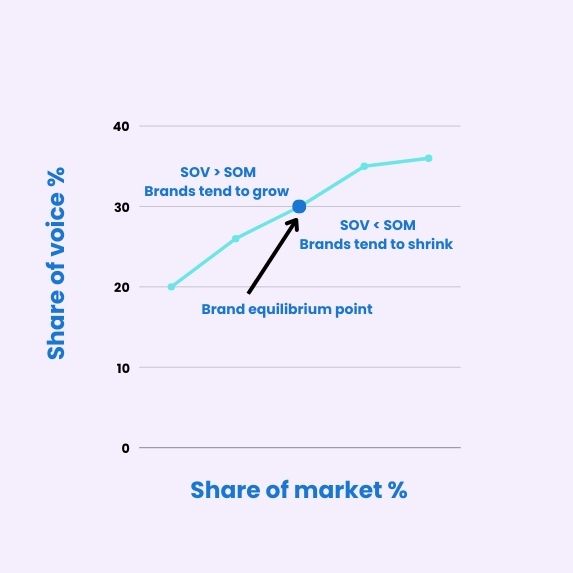
How do you calculate Share of Voice?
The basic formula to calculate Share of voice is:

“mentions” can mean impressions, clicks, media coverage, social chatter, or review volume, depending on the channel.
Example: If your brand has 500 SEO keywords out of 5,000 total industry keywords, your SEO SOV is 10%.
The process to calculate SOV across various marketing channels is:
- Identify relevant channels – Decide if you’re measuring SOV in SEO, PPC, PR, reviews, social media, or a combination.
- Collect data– Use the right Share of Voice tools to collect reliable data across all selected channels.
- Compare against competitors – Share of Voice is not absolute, but a metric to showcase your comparative performance. For best results, include all major competitors in your calculation for an accurate comparison.
- Adjust for quality– The volume of impressions, clicks, and social media mentions alone isn’t always enough. Businesses must consider weighting for sentiment, review ratings, or media authority to add value.
- Set up processes for iterations– Sentiments flicker every day in a growing industry. Make sure you have processes to periodically collect data, make projections, and tweak strategies as necessary.
Share of voice calculator tool
Do you want a quick look at how your business locations are faring against your competitors? Try our simple Share of Voice calculator tool to know more.
Share of Voice Calculator
Want to understand your market standing in detail? Contact the Birdeye team for a local SEO audit.
SOV calculation mistakes to avoid
Measuring your share of visibility across paid advertising, social media accounts, and SEO is a complex process. And if you are just starting, here is a list of mistakes that you must look to avoid when you calculate SOV:
- Not choosing the right tools: Most Share of Voice tools provide insight into a few specific channels, focusing on SEO and social media. It is essential to choose tools that cover all critical channels and allow you to understand the market comprehensively.
- Underestimating competitor analysis: Choosing the key competitors helps accurately measure brand visibility and market share. Beginning with a strong competitor analysis report can set you on the right path.
- Ignoring social media platforms: Brand conversations happen online, and while tracking brand mentions can be tricky on these platforms, they are necessary for a complete picture. Choose tools that integrate with major social media networks for the best results.
- Not considering reputation metrics: Working with reputation metrics like star ratings, review volumes, and sentiment helps qualify the Share of Voice data and make informed business decisions.
- Not defining data limits: Before you start the process, clearly define the Share of Voice data you would be processing. Answer questions about counting non-branded mentions, hashtags, or only name mentions across major networks.
How to measure Share of Voice across channels
Brand share of voice is the sum total of your share of visibility across different marketing channels, so it’s critical for your team to understand individual measurement techniques and their significance.
Let us dive into it.
Share of voice on SEO
A stronger presence on search engine results pages (SERPs) boosts brand awareness, lead generation/conversion rates, and website traffic. But the share of search goes beyond ranking in the top for a few keywords.
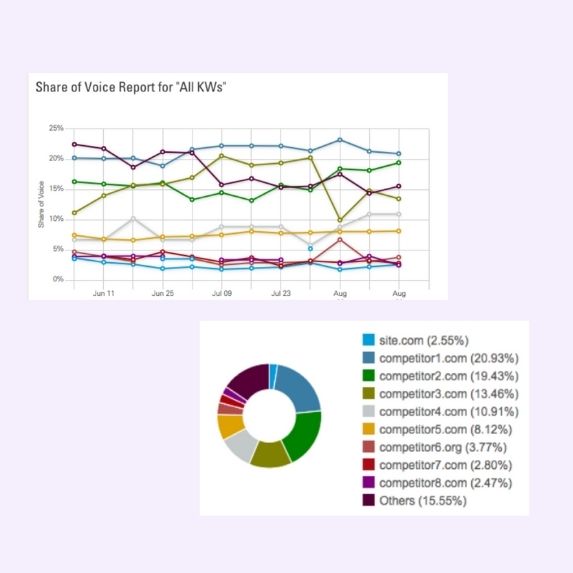
Share of Voice on SEO is the percentage of brand presence on organic search result pages compared to competitors. You can calculate SOV for SEO as a percentage of keywords you rank vs. the total number of target keywords for the specific niche.
SEO share of voice is a critical metric across all industries, but is especially important for businesses that rely on search to reach customers.
Industries where SEO share of voice matters most
- Healthcare and dental groups
- Home services (plumbers, HVAC, pest control)
- Multi-location retail chains
- Restaurants and QSRs
- Real estate agencies
How to improve SEO share of voice
- Optimize each location’s Google Business Profile.
- Target location-specific keywords with landing pages.
- Generate local backlinks and citations.
- Publish high-quality and share-worthy content addressing regional customer queries.
- Monitor monthly search volume of target keywords to optimize content strategy.
- Use centralized search presence management tools like Birdeye Listings AI and Reviews AI to keep location data consistent.
- Encourage users to share testimonials via personal blogs, social media accounts, and more.
Share of voice on PPC
PPC share of voice measures your brand’s visibility on paid advertising channels such as Google Ads, social media ads, and other ad spaces. You can calculate the share of voice on paid channels as the percentage of impressions your campaign secures vs. those of your competitors.

You can view PPC share of voice for Google Ads with the following steps:
- Open your campaigns tab from your Google Ads account.
- Click the column icons and choose “Modify columns.”
- Next, click “Competitive metrics.”
- Choose “Impression share column” to view the chart.
However, there is no straightforward way to do this for other ad platforms, and your marketing team may have to track impressions to understand SOV manually.
Industries where this matters most
- Hospitality and travel
- Food & beverage chains
- Beauty and wellness businesses
- Automotive dealerships
- Education and coaching centers
How to improve SOV on PPC
- Bid on branded and competitor keywords
- Run location-specific ad campaigns
- Optimize ad copy, extensions, and landing pages for conversions
- Use AI-driven insights (like from Birdeye Competitors AI) to identify gaps
- A/B test the creative and CTAs
- Tweak keyword and campaign settings based on Google Ad Analytics
“Birdeye’s competitor analysis feature has been instrumental in understanding how my business stacks up against the competition. By providing insights into their online reputation and customer feedback, it has helped me identify areas where I can improve and differentiate myself in the market.”
Daniel Dye, President, National Rank
Share of voice on PR
Share of voice in the PR and media niche refers to your brand’s visibility in the public domain – news outlets, niche magazines, television reports, and more. You can calculate Share of Voice for PR channels as a percentage of all coverage in a particular publication or comparison with your competitors.

Industries where this matters most
- Enterprise-level brands
- Franchises expanding into new markets
- Regulated industries (finance, healthcare, law)
- Consumer brands facing reputation challenges
How to improve SOV on PR
- Share impactful press releases for new openings, milestones, or product launches.
- Build relationships with local journalists and trade media to optimize PR efforts.
- Feature in thought leadership articles.
- Monitor coverage with social listening or monitoring tools.
Share of voice on social media
This SOV measures how often your brand is mentioned, tagged, or interacted with on platforms like Facebook, Instagram, TikTok, LinkedIn, and X (Twitter) compared to competitors. For a comprehensive picture, you can calculate the share of voice on social media based on impressions, clicks, reach, or brand mentions (from social listening tools).
Higher SOV on social media translates to higher brand awareness, increased website traffic, high community trust, improved digital marketing strategies, and enhanced overall brand market share.
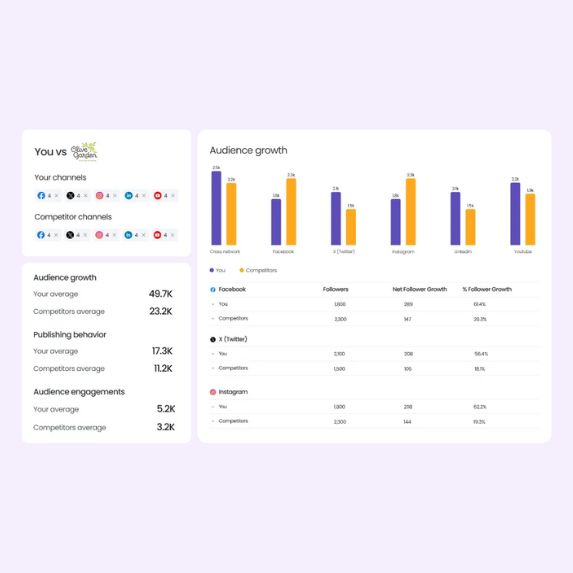
Industries where this matters most
- Hospitality and travel
- Food & beverage chains
- Beauty and wellness businesses
- Automotive dealerships
- Education and coaching centers
How to improve SOV on social media
- Encourage user-generated content (photos, stories, check-ins)
- Run local influencer collaborations
- Post location-specific content regularly using tools like Birdeye Social AI
- Respond to comments and DMs quickly
- Use hashtags and geotags smartly
- Create share-worthy content to boost user engagement
Measure your standing in the market across multiple locations with Birdeye
Want to see the impact of Birdeye on your business? Watch the Free Demo Now.
Share of voice on review platforms
Share of voice on reputation-related platforms (listing and review sites) measures your brand’s visibility across key platforms relative to your competitors. You can calculate the share of voice across Google, Yelp, Facebook, and other industry-specific niche directories about your competitors.

Higher SOV on review platforms results in higher local rankings on Google search, improves trust with potential customers, and enhances revenue for the business.
Industries where this matters most
- Restaurants
- Healthcare providers
- Legal firms
- Home services
- Senior living and assisted care
How to improve SOV on reviews
- Ask every customer for a review post-visit
- Respond to all reviews, especially negative ones
- Resolve complaints promptly
- Use Birdeye Reviews AI to automate and scale review collection
- Analyze review trends to improve operations and prevent negative feedback
Share of voice tools
Here is a list of some of the top Share of Voice tools that multi-location businesses can explore:
Google Analytics
While not a dedicated SOV tool, Google Analytics provides critical data to approximate SEO SOV by tracking organic search traffic and keyword performance compared to competitors. You can also track referral traffic from third-party sources to understand brand mentions.
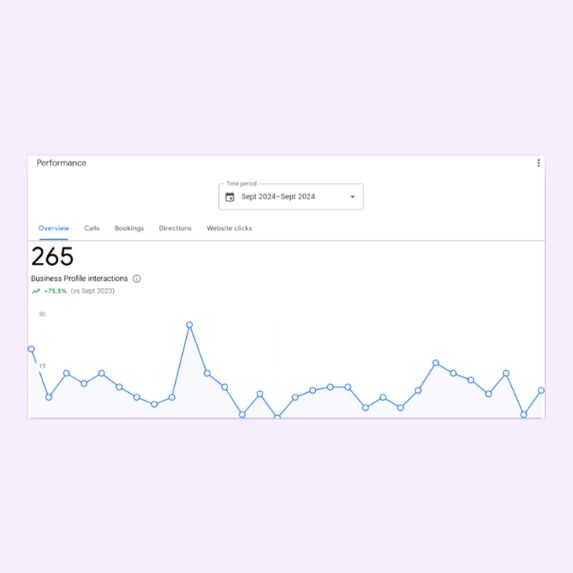
How to use it for SOV:
- Monitor organic sessions for branded vs non-branded terms.
- Compare traffic sources (direct, referral, organic, paid) across locations.
- Use Google Search Console data (integrated) for impression/share analysis.
Semrush
Semrush is one of the most widely used tools for tracking SEO and PPC SOV. It estimates your domain’s visibility on SERPs relative to competitors across keywords. This is great for monitoring search engine SOV across locations.
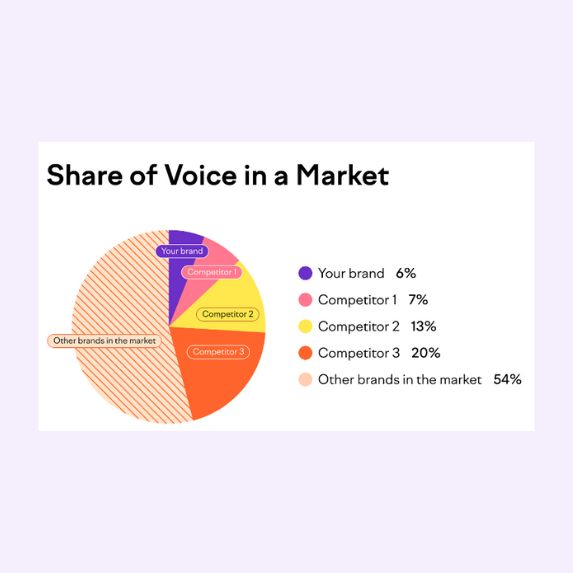
How to use it for SOV:
- Use the Position Tracking tool to monitor keyword share across regions
- Track your Visibility % for a keyword set and compare against known competitors.
- Analyze Ad Copies and keyword overlap for PPC SOV.
Tips for multi-location businesses:
- Set up separate tracking campaigns per location using geo-targeted keywords.
- Use the Competitor Discovery tool to identify regional rivals you may have missed.
- Focus on high-converting local intent keywords to improve ROI and SOV.
Birdeye
Birdeye is a comprehensive tool for measuring share of voice for multi-location businesses. The platform allows businesses to measure review and reputation SOV, going beyond traditional mentions to include customer sentiment, star ratings, volume of reviews, and visibility across review platforms.
With Insights AI and Competitors AI, you can get a 360° view of your brand’s presence compared to competitors, especially across locations.
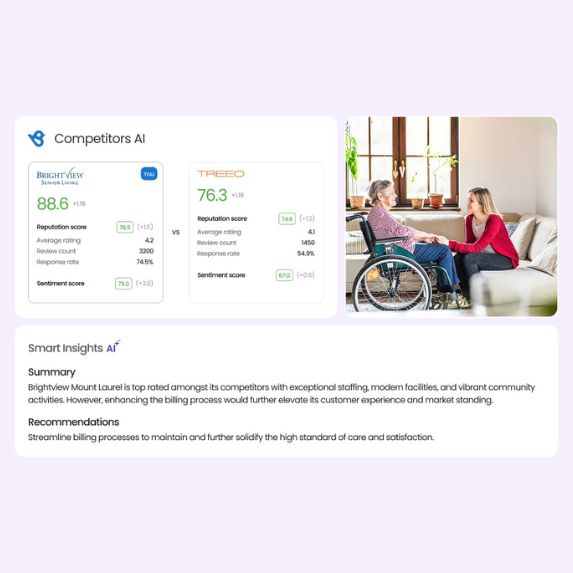
How to use it for SOV:
- Use Birdeye Insights AI to measure mentions, themes, and sentiment trends.
- Use Competitors AI to compare reviews, ratings, and social engagement.
- Track Birdeye Score to benchmark performance across all locations.
Tips for multi-location businesses:
- Analyze location-wise review share and compare it with competitors.
- Track sentiment trends by region to identify problem areas.
- Use automated review request workflows to increase your SOV.
“The insight tools help us look at common themes and commonalities between locations. It gives any business the opportunity to take action. The end goal is that you can make an actionable change. The biggest benefit has been that we could address some issues and come up with solutions by listening to the voice of customers. The insights helped us make changes at the dealership level and accommodate customer needs.”
Miram Ketner, O’Brien Auto Group
Meltwater
Meltwater provides media and PR SOV, measuring how often your brand is mentioned in online and offline channels versus competitors. It excels at identifying media reach, sentiment, and share of coverage.
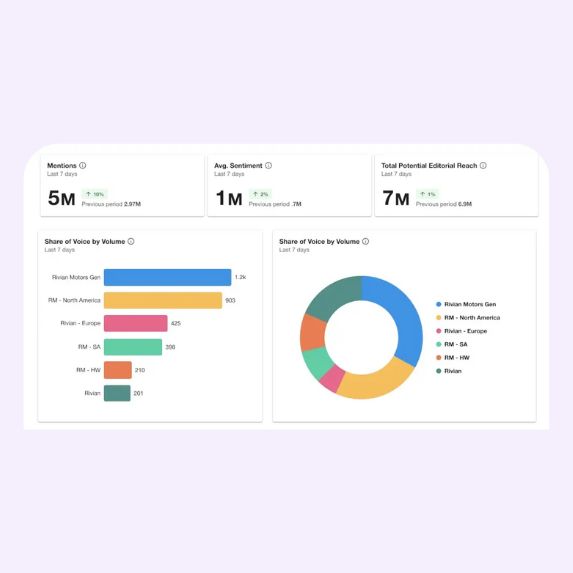
How to use it for SOV:
- Set up brand and competitor alerts across media types.
- Use the Share of Voice dashboard to measure brand mentions over time.
- Monitor sentiment and publication authority to assess PR effectiveness.
Tips for multi-location businesses:
- Track local media coverage per region to measure regional PR success.
- Set location-based filters to avoid skewed data.
- Use Meltwater’s influencer database to support localized outreach.
Mention
Mention is great for real-time social media and web monitoring. It calculates SOV by tracking how often your brand is mentioned online compared to competitors, offering live alerts and sentiment analysis.
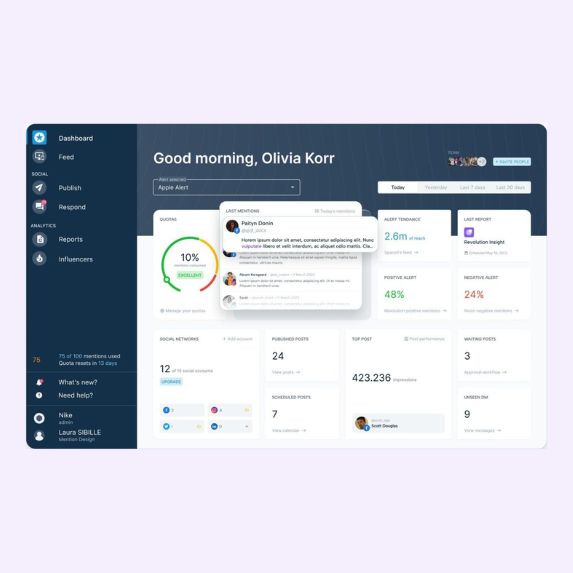
How to use it for SOV:
- Monitor mentions volume across social and web in real time.
- Compare competitor brands and set up dashboards for direct analysis.
- Filter by language, region, and platform.
Tips for multi-location businesses:
- Create separate alerts for each location name + brand to isolate local mentions.
- Monitor spikes in mentions to link with campaigns, crises, or events.
- Combine with review data for a more complete reputation-based SOV picture.
Pitfalls of relying on SOV exclusively
SOV gives insights, but it has limitations:
- Not a complete picture: It measures visibility, not customer sentiment or loyalty.
- Does not measure sentiment: Negative mentions still count towards SOV.
- Can lead to faulty marketing decisions: High SOV with poor sentiment can damage brand trust.
Share of Voice analysis: Best practices for success
If you’re looking to stand out from the crowd with your SOV strategies, here are a few tips that you can employ:
- Look beyond total mentions: High volume of SOV is meaningless if sentiment is negative. Analyze reviews, advertising impressions, and engagement to understand SOV better.
- Break down SOV by location: Generate Share of Voice reports by location as target audience behavior, critical channels, and ad efficiency vary geographically.
- Analyze by channel: While businesses must look at absolute SOV for the bigger picture, focusing on channel-wise Share of Voice analysis can yield significant benefits. This approach can identify gaps, opportunities for improvement, and growth strategies.
Share of Voice – A good starting point
Think of SOV as your brand’s “visibility scorecard.” It’s a critical foundation for brand strategy—but it’s even more powerful when combined with customer experience insights, review sentiment, and AI-driven market intelligence.
Whether it’s SEO, social media, PPC, PR, or review platforms, SOV reveals where you’re leading and losing. But don’t stop at visibility. Pair SOV data with sentiment and competitive intelligence to make strategic moves, not just louder ones.
FAQs on share of voice
It means your brand dominates every conversation or ad impression in the market segment—an extremely rare and usually unsustainable achievement.
SOV (Share of Voice) measures visibility and brand exposure. SOM (Share of Market) measures actual sales and revenue share.
SOV measures brand mentions—share of Engagement measures actions like likes, shares, and comments, which are true audience interactions.
Supercharge your Share of Voice with Birdeye’s GenAI tools
Visibility is just the beginning. Birdeye helps you grow your Share of Voice—and back it with sentiment, competitive benchmarking, and actionable insights. W ith Birdeye, businesses can:
- Be everywhere your customers are: Birdeye Listings AI keeps your brand info consistent across 150+ platforms, helping your locations dominate local SEO and voice search.
- Own the conversation, not just the spotlight: Use Birdeye Reviews AI to generate, manage, and respond to reviews at scale. More 5-star reviews = more trust + more visibility.
- Amplify message across channels: With Birdeye Social AI, you can publish local content, respond in real-time, and boost your brand’s Share of Voice on every platform.
- Compare. Improve. Outperform: Birdeye Competitors AI shows how you stack up on reviews, ratings, and social presence—so you can win in every market.
- Get smarter insights, faster: Insights AI helps you uncover the real drivers of brand sentiment by analyzing review themes, feedback trends, and regional gaps.
Start measuring, managing, and maximizing your Share of Voice today. Watch a free demo to learn more.

Originally published









